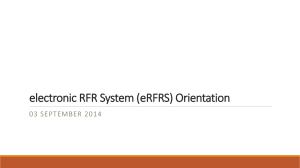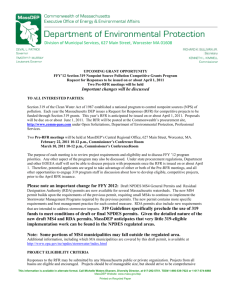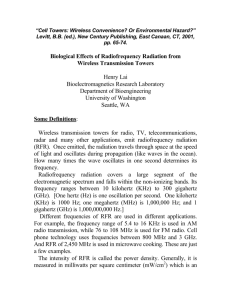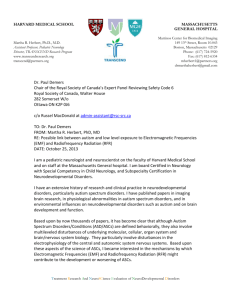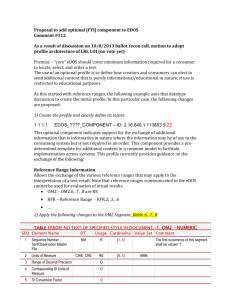An Overview of Radiofrequency/Microwave Radiation
advertisement
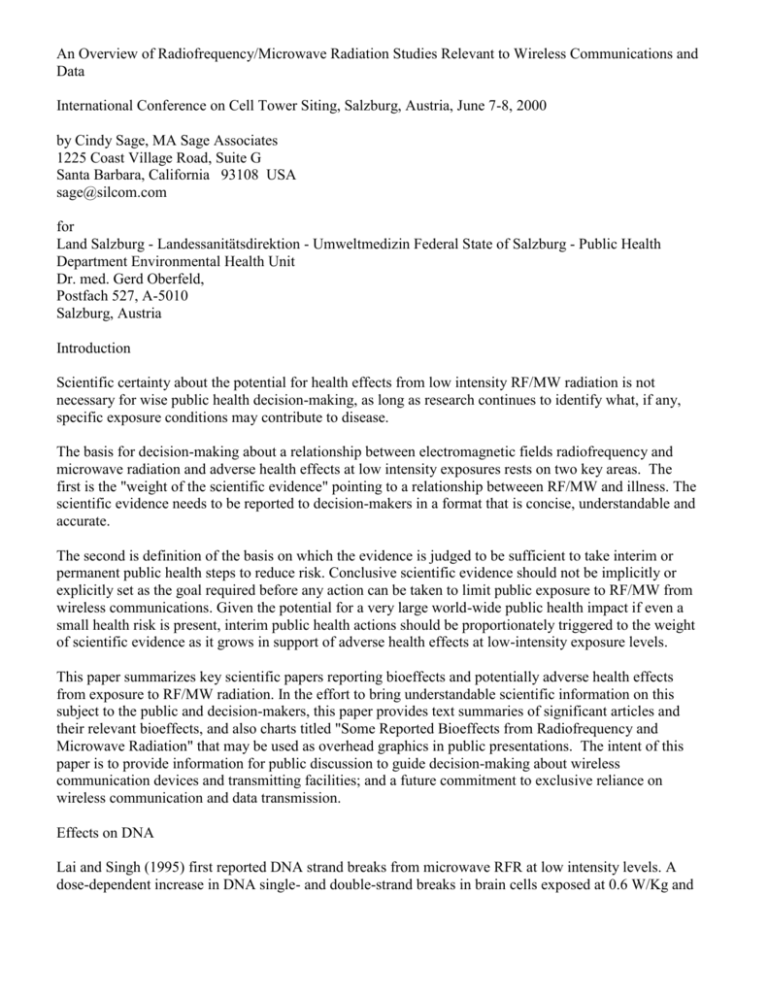
An Overview of Radiofrequency/Microwave Radiation Studies Relevant to Wireless Communications and Data International Conference on Cell Tower Siting, Salzburg, Austria, June 7-8, 2000 by Cindy Sage, MA Sage Associates 1225 Coast Village Road, Suite G Santa Barbara, California 93108 USA sage@silcom.com for Land Salzburg - Landessanitätsdirektion - Umweltmedizin Federal State of Salzburg - Public Health Department Environmental Health Unit Dr. med. Gerd Oberfeld, Postfach 527, A-5010 Salzburg, Austria Introduction Scientific certainty about the potential for health effects from low intensity RF/MW radiation is not necessary for wise public health decision-making, as long as research continues to identify what, if any, specific exposure conditions may contribute to disease. The basis for decision-making about a relationship between electromagnetic fields radiofrequency and microwave radiation and adverse health effects at low intensity exposures rests on two key areas. The first is the "weight of the scientific evidence" pointing to a relationship betweeen RF/MW and illness. The scientific evidence needs to be reported to decision-makers in a format that is concise, understandable and accurate. The second is definition of the basis on which the evidence is judged to be sufficient to take interim or permanent public health steps to reduce risk. Conclusive scientific evidence should not be implicitly or explicitly set as the goal required before any action can be taken to limit public exposure to RF/MW from wireless communications. Given the potential for a very large world-wide public health impact if even a small health risk is present, interim public health actions should be proportionately triggered to the weight of scientific evidence as it grows in support of adverse health effects at low-intensity exposure levels. This paper summarizes key scientific papers reporting bioeffects and potentially adverse health effects from exposure to RF/MW radiation. In the effort to bring understandable scientific information on this subject to the public and decision-makers, this paper provides text summaries of significant articles and their relevant bioeffects, and also charts titled "Some Reported Bioeffects from Radiofrequency and Microwave Radiation" that may be used as overhead graphics in public presentations. The intent of this paper is to provide information for public discussion to guide decision-making about wireless communication devices and transmitting facilities; and a future commitment to exclusive reliance on wireless communication and data transmission. Effects on DNA Lai and Singh (1995) first reported DNA strand breaks from microwave RFR at low intensity levels. A dose-dependent increase in DNA single- and double-strand breaks in brain cells exposed at 0.6 W/Kg and 1.2 W/Kg whole body specific absorption rate (SAR) was found after two hours of exposure to 2450 MHz RFR. Using the sensitive comet assay for DNA breakage developed by NP Singh, it was reported that exposure to both continuous-wave and pulsed RFR produced DNA damage. Published results appeared in two peer-reviewed scientific journals: The International Journal of Radiation Biology (1996;69-4:513521) and Bioelectromagnetics (1995; 16:207-210) A year later in 1998, Jerry Phillips et al reported DNA single-strand DNA breaks exposed to cellular telephone frequencies 813.5 MHz and 836.5 MHz at low SAR (average 2.4 and 24 µW/g-1). Phillips used the same comet assay techniques used by Lai and Singh. This assay is widely used by researchers to detect DNA damage produced by ionizing radiation. Phillips postulated that DNA-repair rates may be affected by exposure to RFR (Phillips et al, 1998). Of related interest, Phillips reported that 60 Hz ELF exposure caused a significant increase in DNA single-strand breaks at 1 G in Molt-4 lymphoblastoid cells (Department of Energy Contractors Conference, Tucson, Arizona, Abstract A-8, November 1998). He postulates that ELF magnetic field exposure can affect both DNA damage and repair processes, and lead to cell death (apoptosis). Conventional wisdom has traditionally held that microwaves are not genotoxic (directly damaging to the genome or DNA) unless high temperatures are created (thermal effect of microwaves on genome). Blank and Goodman (1997) postulate that the mechanism of EM signal transduction in the cell membrane may be explained by direct interaction of electric and magnetic fields with mobile charges within enzymes. Recent studies on DNA show that large electron flows are possible within the stacked base pairs of the double helix of DNA molecules. Therefore gene activation by magnetic fields could be due to a direct interaction with moving electrons within DNA. Electric fields as well as magnetic fields stimulate gene transcription and both fields could interact with DNA directly. Prior work on heat shock proteins by Goodman and Blank is referenced in this paper showing that cellular reponse to EM fields is activation of the same stress response system seen in heating, but at very much lower energy than the response to heat shock (see Gene Transcription and Induction). Chromosome Aberrations and Micronuclei Garag-Vrhovac et al (1999) reported that exposure to microwave radiation of only 10-20 µW/cm2 in workers chronically exposed to 1250-1350 MHz was sufficient to cause an increase in micronuclei (an aberrent form of DNA). Vijayalaxmi et al (1997, 1998) reported that the frequency of micronucleati was increased in the peripheral blood and bone marrow of cancer-prone mice chronically exposed to 2450 MHz microwave radiofrequency radiation. The 1997 publication reported no significant increase in micronucleation; the 1998 publication provided a correction in the calculations and found a significant increase in micronucleation. Maes et al (1993) exposed human peripheral blood lymphocytes to microwaves at 2450 MHz. A marked increase in the frequency of chromosome aberrations and micronuclei (the formation of abnormal chromosome fragments) was reported at nonthermal levels. Chromosome aberrations increased with increasing time exposure (a dose-response). One type of damage seen (the creation of dicentric chromosomes) is considered to be the "hallmark" of ionizing radiation exposure. These results are consistent with results of microwave radiation damage at other frequencies and power densities reported by other researchers (Leonard et al, 1983; Garaj-Vrhovac et al, 1990, 1991; d'Ambrosio et al, 1992). Maes et al (1995) reported that whole blood exposed to the radiating antenna of a GSM base station showed increased chromosome aberrations when placed within a distance of 5 cm or less with two hour exposures. Combined effects of 954 MHz radiofrequency radiation and the chemical mutagen mitomycin C were studied by the same authors using human lymphocytes. Blood samples were exposed to AM radiation from a GSM base station at an estimated SAR of 1.5 W/Kg. Microwave exposure enhanced the harmful effect of the chemical mutagen and showed a clear increase in a form of chromosome aberration (sister chromatid exchange). Single strand DNA breaks were also reported. Effects on ornithine decarboxylase (ODC) Litovitz et al (1993, 1997a, 1997b) and Penafiel et al (1997) tested cells for production of ornithine decarboxylase (ODC) which is an enzyme found in rapidly growing tissues, particularly tumors. They report that amplitude-modulated microwaves (but not FM or continuous wave) significantly affect ODC activity in L929 cells at an SAR of about 2.5 W/Kg at 835 MHz cellular telephone frequency. The effect was reported with several types of amplitude modulation, including a TDMA cellular telephone. The effect was notable at particular modulation frequencies from 16 Hz to 65 Hz, but no effect was reported at 6 Hz or 600 Hz. Importantly, Litovitz reported that no EMF-enhancement of ODC was observed if the field was not constant in time over intervals of longer than 1-10 seconds. If frequency was varied at intervals of 1 second or less, no enhancement of ODC was reported. Gene Transcription and Induction Goswami et al (1999) report that proto-oncogene mRNA levels in fibroblast cells exposed to cellular telephone frequency radiation show increased expression of the Fos mRNA levels. Exposure to 835.62 MHz (frequency modulated continuous wave) showed a 2-fold increase in Fos mRNA levels that was statistically significant. The 847.74 MHz (code division multiple access or CDMA) cellular telephone frequency exposure resulted in a 40% and 90% increase in Fos mRNA that was also statistically significant. These results indicate that specific genes (in this case proto-oncogenes) may be affected by exposure to RFR signals from cellular telephones. Stress Response Daniells et al (1998) found that nematodes respond to microwave radiation with a stress response that can be assayed in the same fashion as for stress related to heat and toxic chemicals. The nematode model for measuring stress response induced by microwave radiation shows that lower power levels induced larger stress responses (the opposite of a simple heating effect). Microwave radiation caused measurable stress and protein damage within cells (induction of hsp or heat shock protein) comparable to damage from metal ions which are recognized to be toxic. The authors conclude that clear biological effects of microwave radiation have been demonstrated in terms of activation of cellular stress responses (hsp gene induction). DePomerai et all (2000) reported an increase in hsp or heatshock protein equivalent to that produced with a 3 degree Centigrade rise in temperature with low-level microwave irradiation at an SAR of only 0.001 W/Kg. Non-thermal microwave radiation disruption of weak bonds that maintain the active form of protein folding at 750 MHz continuous wave may increase free radicals causing DNA damage and interfere with cell signaling that controls cell growth. Cellular Effects of Microwave Radiation Calcium ion balance in living tissue is exquisitely important in the proper function of cell communication, cell growth and other fundamental life processes. Interactions of calcium at the cell membrane have been identified as the first link in bioeffects from RFR. The seminal work of W. Ross Adey and his research team, formerly at the Veterans Hospital at Loma Linda, California has detailed much of the cascade of events by which cellular processes are affected by RFR. Only selected work is presented here, but the reader is referred to the extensive scientific works and testimony on this topic (summarized in Adey, 1997). Adey (1993) provides a comprehensive summary of microwave bioeffects at the cellular level supporting the concept of athermal responses not mediated by tissue heating. Amplitude-modulated or pulsemodulated microwave exposure is a particular focus. Adey discusses the impact of free-radicals in the brain and vascular systems and in the regulation of oxidative stress diseases including Alzheimer's and Parkinson's disease, coronary heart disease, aging and cancer. Microwave exposure at athermal levels may act as a tumor promoter, leading to tumor formation in the absence of other chemical promoters. He cautions that observed bioeffects of low intensity microwave exposure require further investigation, particularly for nonlinear, nonequilibrium cooperative processes. Dutta et al (1989) reported that RFR caused changes in calcium ion efflux from both bird and cat brain tissues, and from human neuroblastoma cells. Significant calcium efflux was found at SAR values of 0.05 and 0.005 W/Kg (a very low energy absorption rate) with RFR at 147 MHz when amplitude-modulated at 16 Hz. Further, enhanced calcium efflux at 0.05 W/Kg peaked at 13-16 Hz and at the 57.5-60 Hz modulation ranges. According to the authors "These results confirm that amplitude-modulated RFR can induce responses in cells of nervous tissue origin from widely different animal species, including humans. The results are also consistent with the reports of similar findings in avian and feline brain tissues and indicate the general nature of the phenomenon." Immune System Cellular Effects Fesenko et al (1999) reported that whole body microwave radiation of male mice at a power density of 1 µW/cm2 caused a significant effect on the immune system. Novoselova et al (1999) reported that five (5) hours of irradiation with microwaves at 1 µW/cm2 stimulated the immune potential of macrophages and T cells. Lyle et al (1983) reported that exposure to sinusoidally amplitude-modulated RFR at nonthermal levels can reduce immune function in cells. A 450 MHz radiofrequency field was modulated with a 60 Hz ELF field. Tests showed that the unmodulated carrier wave of 450 MHz by itself had no effect, and modulation frequencies of 40, 16 and 3 Hz had progressively smaller effects than 60 Hz. Peak suppression of the lymphocyte effectiveness (immune function effectiveness) was seen at 60 Hz modulation. Veyret et al (1991) found that exposure to very low power, pulsed microwaves significantly affects the immune system (either sharp increases or decreases in immune response) at specific amplitude-modulated frequencies. Pulsed microwaves at 9.4 GHz were amplitude-modulated at modulation frequencies between 14 and 41 MHz and at power density of 30 µ/cm2, whole-body average SAR of about 0.015 W/Kg. Importantly, in the absence of amplitude- modulation, exposure to the microwave frequency alone did not affect immune function. It was only with the addition of amplitude-modulation that effects were seen. Elekes (1996) found that the effect of amplitude-modulated RFR and continuous- wave RFR induced moderate elevation of antibody production in male mice (but not female mice). The carrier frequency was 2.45 GHz (which is used in industry) with a modulation frequency of 50 Hz (which is similar to the frequency of some mobile phone systems like TDMA and other ELF-modulated mobile phone systems). Power density was 0.1 mW/cm2, which corresponds to that allowed in the workplace for long-term exposure under Hungarian standards. Exposure was short-term, and the authors remark that the moderate increase in immune function may be related to the brevity of exposure. Blood-brain Barrier The blood-brain barrier has a vital role in the body to exclude toxins from the blood stream from reaching sensitive brain tissues. This barrier is known to protect the brain from toxic or other harmful compounds. It is selectively permeable, allowing some molecules like glucose to pass, but restricting others. It has a dual role in preventing the brain from damage, while stabilizing and optimizing the fluids surrounding the brain. Persson et al (1997) reported that pathological leakage of the blood-brain barrier occurs with exposure to 915 MHz cell phone frequency with both continuous wave (CW) and pulsed (PW) RF exposure. The impact is worst at the lowest exposure levels (0.0004 W/Kg) and worse with continuous wave as opposed to pulsed RF with a maximum effect at 8-50 Hz modulation. 55% of rats exposed to CW but not PW showed significant pathological changes in blood-brain barrier integrity at higher SAR of 1/7-8.3 W/Kg. Salford et al (1994) showed leakage through the blood-brain barrier (or increased permeability) is caused by 915 MHz RFR. Both continuous wave (CW) and pulsed microwave RFR have the ability to open up the blood-brain barrier to leakage. Salford reported that the number of rats exposed to SARs between 0.016 and 5 W/Kg which showed leakage of the blood-brain barrier was 56 of 184 animals, compared to only 5 of 62 control animals. Whether this constitutes a health hazard demands further investigation, but the concept that the blood-brain barrier is clearly breached by both types of low power microwave radiation is concerning. At least ten other scientific papers cited in his reference list also show blood-brain barrier effects of RFR. Blood Pressure Lu et al (1999) reported that exposure to ultrawide-band electromagnetic pulses induced low blood pressure or hypotension in rats. Cardiovascular functions were evaluated from 45 minutes to 4 weeks following exposure to 0.121 W/Kg. A significant decrease in arterial blood pressure (hypotension) was reported but heart rate was not altered. The authors note the UWB radiation-induced hypotension was a robust, consistent and persistent effect. Reproductive Tract Dasdag et al (199) reported that mice exposed to cell phone RFR transmissions had significant changes in structure of their testis. With only 0.141 W/Kg intensity of exposure to both the speech mode and stand-by mode of cell phone transmission, seminiferous tubules in the testes were shrunken in diameter. Exposure was for one minute three times per hour for two hours per day for one month. Histological changes were reported in the testes of rats when the cell phone was in the speech transmission mode, but not in the stand-by mode. Cancer From the genetic building blocks of life to the whole organism, ELF/RFR has been demonstrated to produce bioeffects, which may be deleterious to health. The basic functions of the body, which control proper cell growth, cell proliferation, immune surveillance and toxin protection is shown to be adversely affected, in many cases at environmental levels of exposure. Cancer as a disease endpoint of RFR exposure has been studied for two decades, and both animal and human studies point to a link between exposure under some conditions and cancer. The major concern with mobile telephone technology is its rapid growth around the world, putting millions of users at potential risk, and the emerging evidence for brain tumors. Guy et al (1984) conducted studies for the US Air Force on rats in the first major research specifically designed to approximate effects of microwaves on human beings. Guy remarked there were more than 6000 articles on the biological effects of RFR by 1984, but the question of low-level exposure as a human health hazard was unanswered. In historical perspective, this study provided the first and, to that time, the best study of potential effects from long-term exposure to RFR. John Mitchell (1992), Brooks Air Force Base Armstrong Laboratory, the sponsor of the Guy et al rat study concluded "at our request, Bill Guy took up this challenge and conducted a landmark long-term study that was longer and better conceived and conducted than anything done previously with RFR. To expose animals continuously for more than two years, as envisioned by the experimental protocol, a whole new concept of exposure facilities had to be created." Objectives of the study were "in a population of experimental animals throughout their natural lifetimes, to simulate the chronic exposure of humans to 450 MHz RFR at an incident power density of 1 mW/cm2. Our primary interest was to investigate possible cumulative effects on general health and longevity." (USAFSAM-TR-85-64). The first publication of the Guy rat study was in the 1985 US Air Force USAFSAM-TR-85-64 report "Effects of long-term low-level radiofrequency radiation exposure on rats". It reported a four-fold statistically significant increase in primary malignancies. Chou and Guy (1992) later reported the results of their 1984 cancer studies on rats which found a fourfold statistically significant increase in primary malignant tumors in the 1992 Biolelectromagnetics Journal honouring Dr. Guy on his retirement. The article restated the 1984-85 finding of increased cancer in rats with microwave exposure over the lifetime of the animals. Exposure conditions involved SARs of 0.15 to 0.4 W/Kg of 2450 MHz pulsed microwave (square wave modulated at 8 Hz). Note that the current standard for public exposure is 0.4 W/Kg SAR. Although the Guy study urged immediate follow-up and verification studies, no such studies were conducted for more than a decade. Repacholi et al (1997) conducted mice studies using 900 MHz mobile phone frequency radiation and found a statistically significant 2.4-fold increase in lymphomas. Lymphoma risk was found to be significantly higher in the exposed mice. He concluded that long-term intermittent exposure to RFR can enhance the probability that mice will develop lymphomas. It is noteworthy that the animals were exposed to normal cell phone frequency RFR for only two one-half hour periods per day for eight months. Current human use of mobile phones can exceed 2000 minutes per day for business travelers. A second study of mice and cancer conducted by Repacholi (Harris et al, 1998) with 50 Hz magnetic fields alone did not result in increased cancer rates. The authors conclude that "in contrast, when Pim1 mice were exposed to pulse-modulated radiofrequency fields (900 MHz), a highly significant increase in lymphoma incidence from 22% to 43% occurred. Perhaps the increased incidence of cancer that in some epidemiological studies has been associated with residential proximity to high-current power-distribution wiring results from exposure to high-frequency transients rather than the primary 50/60 Hz magnetic fields. In our study, the magnetic fields to which the mice were exposed were switched on and off in a manner that minimized the production of transients." Hardell (1999) has reported increased risk of brain tumors in humans using cellular telephones. The main type of brain tumors found to occur were malignant glioblastomas and astrocytomas and non-malignant meningiomas and acoustical neuromas. An increased risk (although statistically insignificant) was found for malignant brain tumors on the same side of the head on which the cell phone was used for analog cell phones. The increased risk was 2.45-fold for right side use, and 2.40-fold for left side. GSM users did not have adequate use over time for there to be adequate evaluation of risk. No association between RFR and acoustical neuromas was reported. Adey (1996) found a slight protective effect of microwave mobile phone exposure with respect to brain tumors in rats, where a reduced number of the expected brain tumors resulted. The exposure was for NADC (North American digital cellular) producing a TDMA signal at 836.55 MHz. No brain tumor enhancing effect was found. Apparent "protective" effects (fewer tumors) were discussed but did not reach statistical significance. The authors conclude that TDMA field had no enhancing effect on incidence, type or location of nervous system tumors, although some protective effect may be possible and further research is warranted. Brain Symptoms Reported Using Mobile Phones Mild et al (1998) reported on a joint Swedish-Norwegian epidemiological study of cases using both GSM digital and analogue mobile phones. A statistically significant association between calling time/number of calls per day and the prevalence of warmth behind/around the ear, headaches and fatigue was reported. However, GSM digital phones were less associated with these symptoms than analogue phones. The Swedish data show that GSM users reported less headache and fatigue than for analogue users. Warmth sensations were also reported lower among GSM users. Mobile phone usage was tested in humans (Hocking, 1998) to investigate whether normal use could result in immediate symptoms of the head and neck. He reported that of 40 respondents, headaches with pain radiating to the jaw, neck, shoulders or arm in a few respondents. A majority reported that sensations of head pain started in less than five minutes after commencing phone calls, and another 12 felt the sensation build up as the day progressed. All could distinguish the headaches as different in quality from typical headaches. Eleven cases reported transient effects on vision such as blurring. Fifteen cases reported feelings of nausea or dizziness or a "fuzziness" in the head, which made thinking difficult. One case had long-standing tinnitus, but after a prolonged mobile phone call developed deafness and vertigo lasting five hours. Three cases transferred the mobile phone to a belt. One reported pain in the area at nighttime and another felt a cold area over the place it was worn on the hip. A third person reported pain similar to injured muscles. Twenty eight cases reported symptoms using GSM digital mobile phones and ten with analogue mobile phones. Of the former, thirteen said they had used analogue phones without developing symptoms felt with GSM digital phones. Twenty two said they used mobile phones more than five times per day, and thirty four had changed their use of mobile phones as a result of symptoms. Neurological Effects (Nervous System) Neurologic effects of RFR have been examined at several levels in living organisms. At the ion and molecular levels there are many effects reported and replicated at nonthermal levels. These effects include calcium changes (essential cell communication and growth regulation), neurotransmitters (chemicals that conduct nerve signals and control such things as appetite, mood, behavior, drug responses, sleep, learning and memory), behavioural (memory and learning impairment in rats and humans), and on sleep disorders. Lai (1994a) prepared a review of the literature on neurological effects of RFR on the central nervous system. It provides a concise overview of how the central nervous system (CNS) should normally work, and how RFR has been reported to affect functions of the CNS. The nervous system coordinates and controls an organism's response to the environment through autonomic and voluntary muscular movements and neurohumoral functions. Behavioral changes could be the most sensitive effects of RFR exposure. The movement of calcium ions in brain tissue is changed by RFR. Calcium ions control many brain and body functions including the release and receptor function of neurotransmitters, and any change in their functioning could significantly affect health. Psychoactive Drugs The action of psychoactive drugs depends on proper functioning of neurotransmitters. RFR changes some neurotransmitter functions, which lead to changes in the actions of psychoactive drugs. Lai reports that RFR alters pentobarbital-induced narcosis and hypothermia at 0.6 W/Kg in rats. The nervous system becomes more sensitive to convulsions induced by drugs like pentylenetetrazol. RFR exposure makes the nervous system less susceptible to curare-like drugs that are used in anesthesia to paralyse patients during surgery. Antianxiety drugs like valium and librium may be potentiated in the body with RFR exposure. Lai has postulated that the endogenous opioids are activated by low-level RFR exposure (Lai, 1992, 1994b). This hypothesis can explain increased alcohol consumption seen in rats during RFR exposure, and the lessening of withdrawal symptoms in morphine-dependent rats. RFR-psychoactive drug interactions can be selectively blocked by pretreating animals with narcotic antagonists (i.e., compounds that block the actions of endogenous opioids) before exposure to RFR, suggesting that the endogenous opioid system is activated by RFR (Lai et al, 1986). Serotonin Serotonin activity is reported to be affected by RFR. Drugs which cause a depletion of serotonin (like fenfluramine) by themselves cause a severe and long-lasting depletion of serotonin together with RFR exposure (Panksepp, 1973 in Lai, 1994). Lai (1984) reported that hyperthermic effects of RFR could be blocked by pre-treatment by serotonin antagonists suggesting that the hyperthermia was caused by activation of serotonergic activity by RFR. Drugs which decrease serotonin activity in the brain are shown to suppress aggressive behavior (Panksepp et al, 1973 in Lai, 1994). Serotonin-related functions include sleep, learning, regulation of hormone secretion, autonomic functions, responses to stress and motor functions (Lai et al, 1984). In humans, a cluster of symptoms called serotonin-irritation syndromes include anxiety, flushing, headache and migraine headache and hyperperistalsis which are related to hyperserotonergic states (Lai et al, 1984). Further work to define the relationship between RFR and serotonin has not taken place. Eye Damage Drugs can also enhance the adverse effect of RFR on the eyes. Kues et al (1992) reported that a drug treatment used for glaucoma could worsen the effect of RFR on corneal eye damage. Behavioral Changes Seamans et al (1999) reported that hyperactivity in mice that was induced by drugs was counteracted by exposure to ultrawide-band (UWB) pulsed exposure. The authors indicate the effect may be related to an increase in nitric oxide (NO) production by NOS induced by UWB exposure. The action, or actions of UWB pulses appears to be more effective on locomotor activity than on thermal nociception. Behavioral changes due to RFR are reported in many scientific studies (D'Andrea, 1999). The performance disruption paradigm that is based acceptable levels of RFR on thermal limits does not take into account reports of microwave effects on cognitive performance. D'Andrea (1999) discusses that "it is likely that effects on cognitive performance may occur at lower SARs than those required for elicitation of behavioural thermoregulation at levels that totally disrupt ongoing behaviors". Further, "the current literature on heat stress does not provide data or models that predict the behavioral effects of microwave absorption at low SAR levels". Finally, he notes that "the whole-body and partial-body absorption of microwaves (hotspots) is unique at each frequency in the range of 10 MHz to 100 GHz". Hotspots vary dramatically with RFR frequency, shape and size of the mammal and the animal's orientation in the field (D'Andrea, 1999). Performance of cognitively mediated tasks may be disrupted at levels of exposure lower than that required to behavioral changes due to thermal effects of RFR exposure. "Unlike the disruption of performance of a simple task, a disruption of cognitive functions could lead to profound errors in judgment due to alteration of perception, disruption of memory processes, attention, and/or learning ability, resulting in modified but not totally disrupted behavior." (D'Andrea, 1999). Nervous and behavioral effects of RFR on humans have been reported for five decades. Silverman (1973) is an early reviewer of health effects linked to microwave exposure. She recounts that "the little experimental work that has been done on man has pointed towards possible alterations of the sensitivity of various sense organs, particularly auditory and olfactory threshold changes. There have been numerous case reports, rumors and speculations about the role of microwave radiation in a variety of disorders of the brain and nervous system, such as a causitive role in severe neurotic syndrome, astrocytoma of the brain, and a protective role in multiple sclerosis. In the main, however, the nervous and behavioral effects attributed to microwave irradiation at issue are those found in clinical studies of groups occupationally exposed to various intensities and frequencies of microwaves for variable but generally long periods of time." She discusses nonthermal effects of low-dose, long-term exposure in nine clinical studies of workers exposed to microwave-generating equipment in Czechslovakia, Poland, the USSR and USA. All studies show nervous system effects. Silverman notes that such published studies "virtually ceased in the USA after the 1950's while considerable investigation continued to be reported from the USSR and other eastern European countries". Raslear et al (1993) reported that significant effects on cognitive function in rats were clearly observed with RFR exposure, particularly in the decision-making process. Learning and Memory Lai et al (1994) found that rats exposed for 45 minutes to 2450 MHz RFR at whole-body SAR of 0.6 W/Kg showed a learning deficit in the radial-arm maze which is a behavioral task involving short-term spatial memory function. In searching for the mechanisms for this deficit in learning and memory, Lai found that a drug that enhances cholinergic activity in the brain could block this microwave-induced learning deficit in the maze. Cholinergic systems in the brain are well known to be involved in spatial learning in the radial-arm maze (Lai et al, 1994). Cognitive Functions Koivisto et al (2000) reported that the attention function of the brain and brain responses may be speeded up with exposure to 902 MHz cell phone radiation. Cognitive function in 48 healthy humans was tested following exposure to the cell phone radiation field. The results showed that the exposure speeded up response times in simple reaction time and vigilance tasks and that the cognitive time needed in a mental arithmetics task was decreased. The authors suggest that the electromagnetic field emitted by a cellular telephone may have a facilitatory effect on brain function, expecially ub tasks requiring attention and manipulation of information in working memory. Krause (2000) reported on effects of RFR from cell phones does not alter the resting EEG but modifys the brain responses significantly during a memory task. At 0.3 to 0.44 W/Kg SAR, exposure to cell phone radiation results in changes to cognitive thinking and mental tasks related to auditory memory retrieval. Preece (1999) reported that RFR at cell phone frequencies speeded the rate at which humans responded to tasks (reaction time) but did not affect memory. Students were exposed to both analog and GSM digital phone signals for one half an hour, and then were tested for memory and speed and accuracy on cognitive tests. The higher the power from the cell phone signal, the faster the response time was reported, indicating the cell phone signal is not biologically neutral but can affect the brain's activity. Sleep Sleep disruption related to RFR has been reported in several scientific studies. Mann et al (1996) reported that RFR similar to digital mobile telephones reduced REM sleep in humans and altered the EEG (brain wave) signal in humans during REM sleep. REM sleep is essential for information processing in the brain, particularly with respect to learning and memory functions. It is thought to be needed for selecting, sorting and consolidating new experiences and information received during the waking state, and linking them together with old experiences. Borbely et al (1999) reported tha sleep patterns and EEG are changed with 900 MHz cell phone exposure during sleep. Alternating 15-minute on-and off-intervals in RFR exposure produced a reduction in the amount of waking after sleep onset from 18 to 12 minutes. The maximum rise occurred in the 10-11 Hz and 13.6-14 Hz bands during the initial part of sleep. The results demonstrate that cell phone radiofrequency exposure may promote sleep and modify the sleep EEG. Message from Cindy Sage, MA
